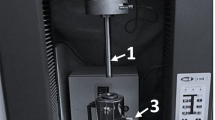Summary
A study was made in this investigation of the influence exerted by the time of holding of powder under load, repeated compaction, percentage moisture content, and plasticizer on the compressibility of molybdenum disilicide. In addition, the distribution of forces during compaction and the elastic recovery of compacts were examined.
The density of a molybdenum disilicide compact is independent of the time of holding under load, and, consequently the compaction process may be carried out practically instantaneously. It is desirable to employ double or treble compaction with intermediate rubbing through a sieve, the first compaction being performed at a pressure of 35–40 kN/cm2 and the second at a pressure of 15–25 kN/cm2.
It was established that the compaction of molybdenum disilicide is described by semilogarithmic functions of compaction pressure and relative volume. The constants of these equations were determined.
The optimum moisture content for the compaction of MoSi2 powder is 1–3%, and the optimum amount of bentonite addition 3–4%.
The use of punch face and die wall lubrication reduces friction between the powder and the die walls, thereby increasing the density of the compact.
The minimum elastic recovery (0.4%) is observed at a compaction pressure of 20 kN/cm2.
Similar content being viewed by others
Literature cited
G. V. Samsonov, Refractory Compounds [in Russian], Moscow, Metallurgizdat (1963).
P. S. Kislyi and G. V. Samsonov, Poroshkovaya Met., No. 3, 31 (1962).
P. S. Kislyi, Poroshkovaya Met., No. 5, 68 (1962).
S. Ya. Plotkin and G. V. Samsonov, Vestn. Mashinostr., No. 5, 53 (1959).
B. N. Babich, K. I. Portnoi, and G. V. Samsonov, Metalloved. i Term. Obrabotka Metal., No. 1, 31 (1960).
G. V. Samsonov and V. S. Neshpor, Dokl. Akad. Nauk SSSR,104, 405 (1955).
H. Unckel, Arch. Eisenhüttenwesen,18, 161 (1945).
P. S. Kislyi and G. V. Samsonov, Poroshkovaya Met., No. 3, 31 (1962).
M. Yu. Bal'shin, Powder Metallography [in Russian], Metallurgizdat (1948).
Author information
Authors and Affiliations
Additional information
The author thanks G. V. Samsonov, Corresponding Member, Acad. Sci. UkrSSR, for his assistance in a number of problems which arose during this investigation and evaluation of the results obtained.
Rights and permissions
About this article
Cite this article
Struk, L.I. The process of compaction of molybdenum disilicide. Powder Metall Met Ceram 5, 261–265 (1966). https://doi.org/10.1007/BF00778621
Received:
Issue Date:
DOI: https://doi.org/10.1007/BF00778621




